Sphinginae subfamily
Sphingini tribe:
 |
This species has not been reported in Monterey County, but may be
there as a very rare stray. The moth is a very
strong flier and is frequently encountered far north of its usual range.
|
 |
This large bodied moth flies in tobacco fields and vegetable gardens
(potatoes, tomatoes) and wherever host plants are found. |
 |
This species has been recorded in Monterey
County.
If you grow tomatoes, you have probably encountered it.
Larvae get very large and can strip a tomato plant. |
 |
Sphinx chersis
HS/USGS, the Northern Ash
Sphinx or Great Ash Sphinx
The upperside of the forewing is soft dark-gray to blue-gray with
a series of black dashes, one reaching the wing tip. Note grey
thorax with narrow black lines.
|
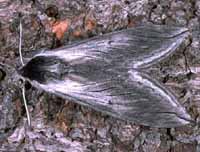 |
Sphinx perelegans adults fly in montane woodlands and mixed chaparral-type vegetation as a single brood
in the north, with adults mainly on the wing in June and July.
It flies from dusk until after midnight. Note dark thorax. |
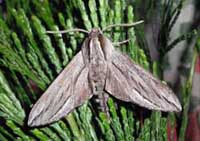 |
Sphinx sequoiae
WOQuestionable,
the Sequoiae Sphinx
This species is not recorded in Monterey County, but it might be present.
Adults fly as a single brood in the desert and in pinyon-juniper
woodland from May to August. |
Smerinthini Tribe:
 |
This one is quite similar to Pachysphinx modesta, with modesta
being smaller and darker.
Moths should be on the wing from June-August.
|
 |
Smerinthus cerisyi
HS/LH/USGS, the Cerisyi's
Sphinx or One-eyed Sphinx, Larvae feed on poplars and willows.
Flight would be from late May-July as a single brood.
|
Macroglossinae subfamily
Dilophonotini Tribe:
 |
Hemaris diffinis
LH/USGS,
the Snowberry Clearwing or Bumblebee Moth,
The moth flies along forest edges and in meadows, gardens and
brushy fields. Day-flying adults nectar at lantana, dwarf bush honeysuckle,
snowberry, orange hawkweed, thistles, lilac, Canada violet, etc.
|
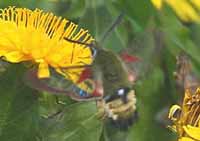 |
Hemaris senta
HS, California clearwings have brownish-olive
or olive-green heads and thoraxes. The abdomen, which has a broad
yellow band, is black or olive-green above and yellow below. Their
wings have a very narrow brown border and the clear parts of the
wings have a steel-blue luster.
|
Philampelini Tribe:
 |
This moth is recorded for Monterey County,
but it should be present wherever grapes are found.
Fight would be from June to August. Larvae feed on grape foliage. |
Macroglossini Tribe:
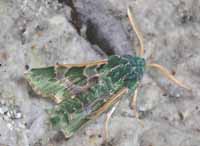 |
Arctonotus lucidus
HS/LH/USGS, the Pacific Green
Sphinx Moth or Bear SphinxThis species is confirmed in Monterey
County.
It tends to be an late winter-early spring flier, on the
wing in the early evening. It comes to lights at night. |
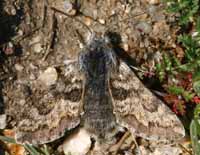 |
Euproserpinus euterpe adults fly in pastures and fallow fields
as a single brood from late January-February-April. They nectar at
flowers of filaree (Erodium) and Nemophila during the
warm parts of the day.
This species is listed as "threatened" in its known
range. |
 |
Euproserpinus phaeton,
the Phaeton Primrose Sphinx, WO ?? see below
Adults nectar at flowers during the warm parts of the day.
Euproserpinus phaeton adults fly swiftly and close to the ground over
dry washes and flat areas in deserts as a single brood from
February-April.
|
 |
Hyles lineata
HS/LH/USGS,
the White-lined Sphinx
Adults usually fly at dusk, during the night, at dawn, and during the
day. Moths nectar at salvia and oviposit on Epilobium cana (California fuchsia) and
Hooker's Evening Primrose in LA county. |
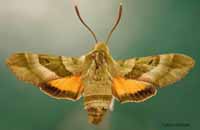 |
Adults fly in the afternoon from April-June in oak woodland and
pine-oak woodland in foothills, nectaring from chia, heartleaf
milkweed, golden currant, bluedicks, fairyfans, vetches,
thistles, hedgenettles, etc. |
|
|